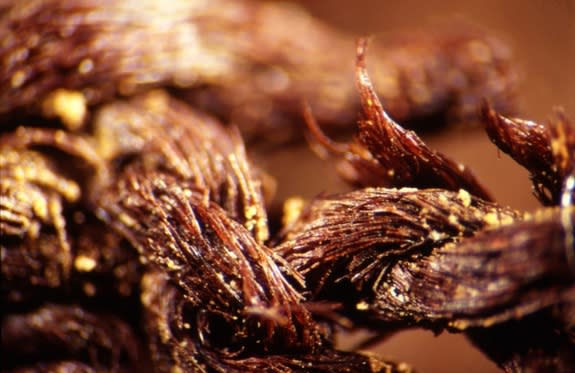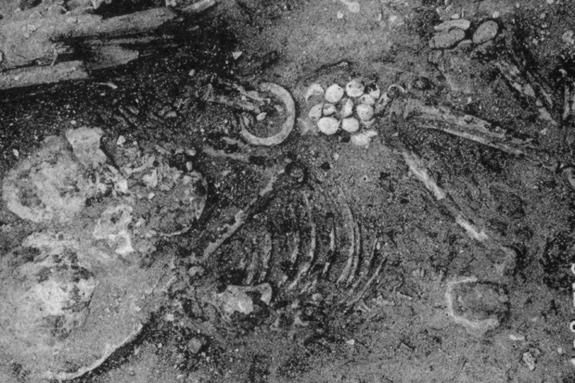Oldest Evidence for Egyptian Mummy Making Discovered
Three thousand years before King Tut's body was brushed with embalming oils and wrapped in linen to rest in a gold-filled tomb, prehistoric Egyptians seeking immortality may have experimented with their own recipes to preserve the dead for the afterlife.
Scientists previously thought that mummy making began in Egypt around 2600 B.C., during the era when the pyramids of Giza were built, known as the Old Kingdom. But now scientists say they have found traces of complex embalming agents on much older bits of burial shrouds that had been sitting in a museum for nearly 100 years after they were dug up along the Nile Valley.
The newly examined linens were peeled from bodies buried at the Egyptian sites known as Badari and Mostagedda during the Late Neolithic and Predynastic periods, between 4500 B.C. and 3100 B.C. Archaeologists first found these pit graves during a British expedition to the region in the 1920s, and researchers had previously assumed that the hot, dry desert sand naturally mummified any well-preserved corpses from this era. [See Photos of the Mummies & Mummy Wrappings]
The harsh environment definitely encouraged preservation, and may have even inspired mummification practices in the first place. But the new research, detailed today (Aug. 13) in the journal PLOS ONE, suggests Egyptians at that time were cooking up embalming mixtures made from animal fats, as well as tree resins and plant extracts that contained powerful antibacterial elements.
The study "highlights the enormous potential of museum collections accumulated a century ago for giving us new insights into the ancient past," said Alice Stevenson, curator of University College London's Petrie Museum of Egyptian Archaeology, who was not involved in the study.
Recipe for death
Study leader Jana Jones of Macquarie University in Sydney, Australia, and colleagues examined about 50 samples from prehistoric mummy wrappings, mostly taken from tombs at Mostagedda in modern-day Egypt's Asyuti Province. Archaeologists had often noted these textiles, now housed at England's Bolton Museum, looked suspiciously waxy, as if they were covered in resin, said study researcher Stephen Buckley, an archaeological chemist at the University of York in England.
"I thought there may actually be something here," Buckley told Live Science. "I also knew you couldn't tell by looking, because sometimes bodies can produce shiny substances depending on the context they're in. There was very tentative evidence that there might be something interesting there, but not exactly what it was."
These shiny substances were indeed artificial, a chemical analysis showed. In most cases, the recipe consisted of about three-quarters animal fat or oil, mixed with a small amount of pine resin, aromatic plant extract, a sugar or plant gum, and a natural petroleum. The team found chemical signatures of heating, suggesting these substances had been processed in antiquity.
"It was a recipe that was relatively consistent [across all samples], and it was the same recipe, essentially, that was being used later in pharaonic, classical Egyptian mummification," Buckley said.
The tree resin and aromatic plant extract, in particular, have powerful antibacterial properties. Though these elements wouldn't have entirely stopped the decay of the body, they would have at least stopped bacteria from flourishing, Buckley said.
The embalming ingredients also suggest that these prehistoric people had a wide trade network. Some of the compounds were imported far from the heart of Egypt, including the pine resin, which came from southeastern Anatolia, in modern-day Turkey, Buckley said.
Eternal life
Prehistoric Egyptians didn't leave behind embalming manuals or treatises about their views on the afterlife like their descendants did. But these early attempts at mummification may have been the seeds of the Egyptian idea that immortality required the body's preservation, Buckley said. [See Images of Egyptian Mummification Process]
Artificial mummification isn't unique to Egypt. The oldest mummy-making society was the Chinchorro culture in northern Chile and Peru, which has mummies that date back to 6000 B.C. Buckley said it's interesting that most cultures that practiced mummification lived in dry, desert climates, where bodies would be preserved naturally to some extent. He suspects people in these regions may have connected natural body preservation with cheating death, and may have later developed salves to aid in that process.
In Egypt, the choice of embalming agents might have been accidental at first.
"What makes most sense is perhaps these ingredients were chosen for their symbolic significance initially," Buckley said. For example, the team discovered traces of a chemical that's found only in sea sponges in the Mediterranean. These regenerative animals may have held some symbolic significance related to rebirth.
"They likely noticed that there was some soft-tissue preservation," Buckley said. "And from that, they recognized that these embalming agents were helpful to preserve the body, and if you can preserve the body, you can perhaps cheat death and survive into the next life. That was the late-Egyptian mindset, and it seems [earlier cultures] were already thinking on those sorts of lines."
Mummies without bodies
Unfortunately, the bodies that were once wrapped in these linens have been lost. At the time these finds were excavated, British archaeologists were more interested in the artifacts — the pots, jewels, shells and other goods placed in the graves. [Photos: Image Gallery: The Faces of Egyptian Mummies Revealed]
"There was some discomfort with dead bodies, quite frankly, and so we don't actually know for sure where the bodies are," Buckley said.
While perhaps squeamish about the dead, British archaeologists who dug up ancient sites in Egypt during the early 20th century were interested in textiles.
"What happened was the textiles from the bodies were recovered and taken to the Bolton Museum in the northwest of England because of the local interest in textiles," Buckley explained. But knowing Egyptology, he said he wouldn't be surprised if the bodies turned up in storage somewhere.
Though Egyptologists have since embraced the study of bones and soft tissue, Buckley said the field remains quite conservative, and stuck on a date of about 2600 B.C. for the origins of mummification. The new research pushes back the start of intentional mummy making by about 1,500 years.
But Stevenson noted, as did the authors of the paper, that other archaeologists have been turning up evidence that challenges this date in recent years. For example, excavations at the site of Hierakonpolis have revealed resin-soaked linens on bodies dating back to the fourth millennium B.C. Stevenson said she wasn't entirely surprised to learn that prehistoric communities were similarly attentive to the bodies of the deceased.
"Badarian graves are notable in the Egyptian archaeological record for the array of material brought together through expansive networks of exchange, and in these burials are amongst the earliest evidence in Egypt for elaborate body ornamentation," Stevenson told Live Science in an email. "So this fits in very well with that cultural picture."
But, remarkably, this is the first study "to demonstrate the presence of resin-soaked linen a few centuries earlier than was previously attested," Stevenson said, and it is "important to have this scientific confirmation of the 'recipes.'"
Follow Megan Gannon on Twitter and Google+. Follow us @livescience, Facebook& Google+. Original article on Live Science.
Copyright 2014 LiveScience, a TechMediaNetwork company. All rights reserved. This material may not be published, broadcast, rewritten or redistributed.




